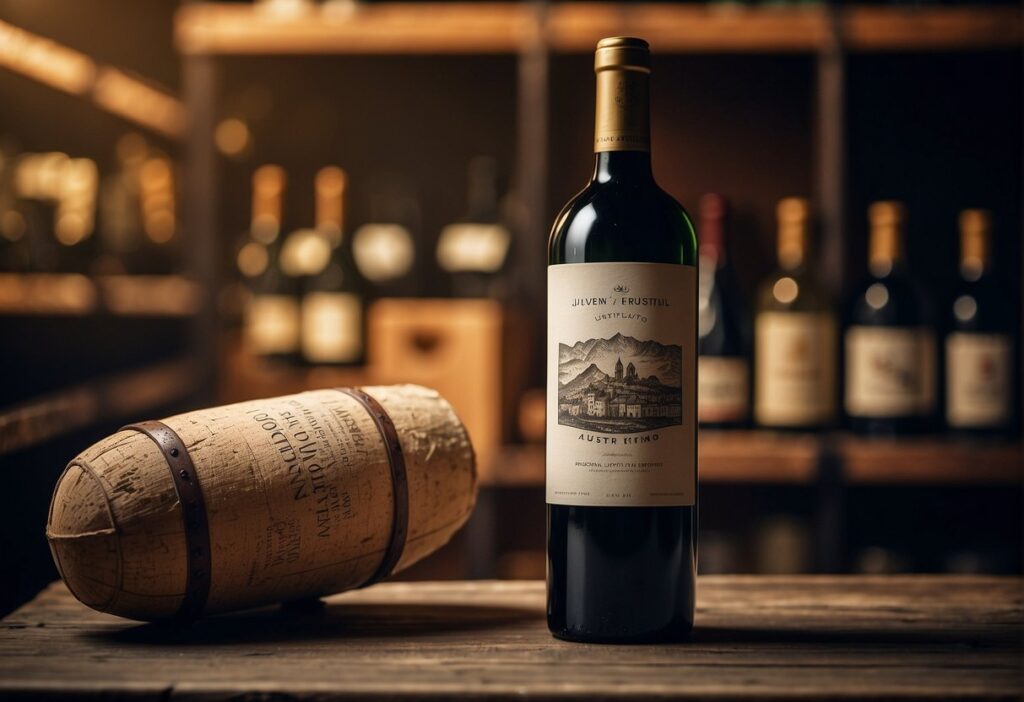Transforming a part of your home into a wine cellar can be a rewarding venture that adds both style and functionality. To create a wine cellar, you need the right location and conditions to ensure your wine ages well.
Think about spaces like basements or closets that can be adapted to maintain steady temperature and humidity control.

Utilize your DIY skills to construct a space that not only stores your wine but also displays it beautifully. For example, you might insulate a closet to protect your wine collection. A passive-cooled wine cellar can be built at a reasonable cost, holding hundreds of bottles without needing complex systems.
By focusing on proper sealing and insulation, you’ll maintain optimal storage conditions. A door that seals tightly ensures that temperature and humidity remain constant.
Learn from detailed guides on how using materials like 1×3 furring strips and appropriate insulation can help maintain the integrity of your cellar. Your effort can turn a simple room into an essential space for any wine enthusiast.
Planning Your DIY Wine Cellar
Creating a DIY wine cellar involves selecting the right spot in your home, understanding how to properly store wine, and carefully designing the layout to suit your needs. Each step is crucial to ensuring that your wine collection is both protected and accessible.
Choosing the Location
The ideal location for your wine cellar should be a space with consistent temperatures and minimal light. Basements are perfect due to their naturally cooler environment, but closets can work if they are insulated.
Consider an area that is not subject to regular temperature changes. Avoid places near heating systems or pipes to prevent temperature fluctuations. Using rooms not frequently used can help maintain a stable environment for your wine bottles. Making these choices is an essential first step in your home improvement project.
Understanding Wine Storage Needs
Proper wine storage is vital for maintaining flavor and quality. Wines need a controlled environment with temperatures between 45°F and 65°F and a humidity range of 50% to 70%. Having a space that adheres to these conditions helps in the development and aging of the wine.
Seal the room well, with doors that create an airtight seal, preventing any loss or gain of temperature. A dedicated wine cooling system can be installed for more consistent control.
Utilize resources that guide on sealing doors, such as those noted in these DIY wine cellar plans.
Designing Your Wine Cellar Layout
Designing the layout involves more than just storage space; it must be efficient and aesthetically pleasing. Plan for shelves that accommodate both current and future wine collections.
Materials like wood give warmth, while metal offers a modern look. Consider the accessibility of each wine bottle. An organization system, like labeling, helps in locating specific wines quickly.
Incorporate enough space for walking and viewing the collection comfortably. Consulting detailed wine cellar plans can offer insights into effective designs and layout strategies.
Constructing the Wine Cellar
Building a wine cellar involves careful planning and detail. It’s essential to focus on elements like insulation and vapor barriers, securing your space with drywall or green board, and ensuring a reliable cooling system is in place.
Insulation and Vapor Barriers
Proper insulation is crucial to maintain the right temperature and humidity in your wine cellar. Start by selecting insulation that suits your needs. Fiberglass or rigid foam are popular choices due to their effectiveness in reducing temperature fluctuations.
Install a vapor barrier to prevent moisture build-up. A 6-mil plastic sheeting works well for this, acting as a shield against moisture infiltration.
Secure the vapor barrier with high-quality duct tape, ensuring it’s placed between the wall covering and insulation. This method helps create a stable environment.
Drywall and Green Board Installation
Once your insulation and vapor barriers are in place, it’s time to install the protective layers that will form the cellar’s interior surface. Drywall is a straightforward choice, offering easy installation and a smooth finish.
Consider using a green board for added moisture resistance. Green board is similar to regular drywall but includes a wax coating, making it more resistant to humidity.
Attach the drywall or green board securely to the wall frame. Pay attention to properly sealing joints and seams to enhance insulation and minimize air leaks.
Installing a Cooling System
A reliable cooling system is essential to keep your wine cellar at the optimal temperature. Standalone cooling units, like wall-mounted systems, suit smaller cellars and require minimal installation.
For larger spaces, consider a ductless mini-split system. These systems offer precise temperature control and are more efficient for bigger cellars.
Install the system at an appropriate height to allow for good air circulation. Regular maintenance and temperature monitoring are important to maintaining your wine’s condition.
Make sure your cooling system suits the cellar size and the number of wine bottles stored.
Wine Rack Solutions

Creating the ideal storage for your wine collection is essential to maintain its quality. Understanding the difference between custom and pre-made wine racks will help you find the best solution for your needs and space.
Custom Wine Racks
Custom wine racks offer the flexibility to design a storage solution that perfectly fits your space and style. You can choose materials, size, and shape to meet your specific requirements.
Custom options are ideal for unique spaces or for those wanting a particular aesthetic. Materials like wood, metal, and acrylic are popular choices for custom wine racks.
You can also incorporate features like built-in lighting or temperature controls. Custom solutions can be more expensive, but they provide a unique and personalized touch to your wine cellar.
Benefits of custom wine racks:
- Tailored fit for your space
- Unique design possibilities
- Potential for additional features
Consider working with a professional designer or carpenter to achieve the best results. This will ensure the rack is both functional and visually appealing, complementing your wine cellar’s overall design.
Pre-Made Wine Rack Options
Pre-made wine racks are convenient and often more affordable than custom ones. They come in a variety of styles and materials, allowing you to find something that suits your taste and budget.
These racks can be easily found online or in stores, making them accessible for quick setups.
Popular types of pre-made wine racks:
- Countertop racks for small collections
- Wall-mounted racks to save floor space
- Floor-standing racks for larger collections
Pre-made racks are typically easy to assemble and can be moved if needed. They offer a straightforward solution for those who want to organize their wine without the commitment of custom designs. Consider the size of your collection and available space to choose the most suitable option.
Final Touches and Maintenance

Final touches can greatly enhance the look of your wine cellar, while regular maintenance ensures it runs efficiently. Proper care includes managing humidity levels and considering the right wall finish to complement both aesthetics and functionality.
Ideal Humidity Levels and Monitoring
Maintaining correct humidity in your wine cellar is crucial for preserving wine quality. Ideally, you should aim for humidity levels between 50% and 70%. This range helps keep corks from drying out, which in turn prevents oxidation.
To monitor this, use a reliable hygrometer. Digital models often provide more accurate readings and offer convenient features like alarms or historical data tracking.
You might also consider a humidity control system, especially if you face extreme humidity changes in your area.
Regular checks are important. Even once every week can help you identify any irregularities early. Set alarms or reminders to ensure consistent monitoring and maintenance. Keeping levels stable protects your collection and enhances its longevity.
Wall Finish and Aesthetics
The wall finish is a key element in crafting the cellar’s atmosphere. For a classic look, consider using wood paneling or stone veneer. These materials not only add elegance but also contribute to insulation.
Paint can also be a good choice if you prefer a modern or minimalist design. Select paints with moisture-resistant properties to ensure durability. Light colors can make the space appear larger, while darker shades can create a cozy ambiance.
Incorporating artwork or arches can add a personal touch. Shelving or racks should match your chosen wall finish to maintain a cohesive design. Make sure everything aligns to create a welcoming and functional wine cellar environment.
Innovative Wine Cellar Ideas

Transforming spaces into unique wine cellars can enhance both functionality and style in your home. Whether you’re utilizing a basement or a closet, innovative designs can help create the ideal storage for your wine collection.
Basement Wine Cellar Transformation
A basement is an ideal spot for a wine cellar due to its naturally cool and stable environment. By converting your basement into a dedicated wine storage room, you can maintain an optimal temperature for your wines. Insulation and a vapor barrier are crucial to prevent moisture issues.
Consider installing custom wine racks to efficiently organize your collection. Incorporate a tasting area with a small table for an added touch.
Strategic lighting can highlight your bottles, making the cellar not just a storage space but a focal point in your home. Using a minimalist design, you can achieve a modern yet functional look.
Spiral Wine Cellars
Spiral wine cellars offer a space-saving solution for wine storage. These are cylindrical, underground storage units that can be integrated into the floor of your kitchen or living area.
Not only do they provide ample storage, but they also add a unique element to your home design.
Building a spiral wine cellar involves creating a vertical shaft beneath a floor. It features a spiral staircase that allows access to your wine bottles, stored in a circle around the staircase.
Materials like reinforced concrete and glass can be used to ensure durability and aesthetic appeal. This type of cellar requires professional installation but can dramatically improve the look and value of your home.
Closet Wine Cellar Conversion
Turning a closet into a wine cellar is a popular DIY project, especially for homes with limited space. Insulating the closet and adding a cooling unit ensure the wines are kept at ideal conditions.
You can use compact wine racks and shelves to maximize storage in a small area. Lighting plays a crucial role here: LED strips or recessed lights can add elegance without raising the temperature.
This setup suits smaller wine collections or those looking to keep a select few bottles in a convenient location. A clear glass door can both stylishly showcase your collection and help maintain temperature control.
Underground Wine Cellar Creations
Creating an underground wine cellar capitalizes on the earth’s natural insulating properties. This option provides excellent control over temperature and humidity, critical in preserving wine quality.
Designing an underground space allows for a larger wine collection to be accommodated with ease.
To build an underground wine cellar, you might need to do some excavation. This often involves adding structural support and professional expertise.
You can opt for stone or brick walls to give a traditional feel or go for sleek, modern finishes for a contemporary look.
This type of cellar can serve as a private retreat for wine enthusiasts. It offers a dedicated space for wine appreciation and enjoyment.

